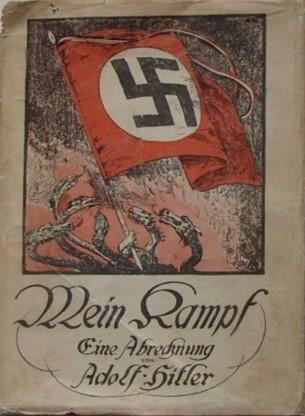Mein Kampf: Summary and Ideological Analysis


Historical Context and Hitler’s Background
After World War I, Germany was in turmoil. The 1919 Treaty of Versailles imposed heavy reparations and territorial losses, contributing to hyperinflation, unemployment, and social unrest. Many Germans embraced the “stab-in-the-back” legend, blaming Jews, socialists and liberals for the nation’s defeat. In this volatile Weimar environment, ultranationalist, racist, antisemitic and anti-communist movements gained strength. Adolf Hitler – an Austrian-born army veteran exposed from youth to ethnic German nationalism and antisemitism – emerged as a rabble-rouser in Munich. He served as a message-runner in WWI (earning two Iron Crosses) and was embittered by Germany’s collapse. In November 1923 Hitler led the Beer Hall Putsch (a failed coup) and was imprisoned. In Landsberg prison (1924–25) he wrote Mein Kampf as a mix of autobiography and political manifesto, intending it as a propaganda platform for his ideology.
Postwar crises: Germany’s economy collapsed under hyperinflation and the Great Depression. This chaos undermined the Weimar Republic’s democracy and fueled support for radical right-wing ideas.
Social tensions: The harsh Versailles terms bred national resentment. German nationalists promoted a myth that “November criminals” and Jews had betrayed the country. Fear of Bolshevism (after the Russian Revolution and German communist uprisings) also pushed many toward the Nazi Party.
Hitler’s personal influences: As a young man Hitler absorbed German nationalist and antisemitic ideas in Austria and Munich. After WWI he became active in Munich’s extremist politics, which were marked by antidemocratic and anti-communist sentiments. His wartime service and belief in Germany’s betrayal profoundly shaped the content of Mein Kampf.
Themes of Mein Kampf
Mein Kampf blends autobiography with virulent political propaganda. Its chapters convey several key themes:
German Nationalism and Volk Ideology: Hitler portrays the German “Volk” (people) as a racial community destined for greatness. He calls on Germans to unite and elevate their nation. For example, he declares it a “sacred mission” of the German people to assemble “the most valuable racial elements” and raise them “to the dominant position”. He also calls for revenge against Germany’s wartime enemies (e.g. France) to restore national honor.
Racial Theory and Antisemitism: The book is notoriously racist. Hitler defines races in quasi-biological terms and insists that Germans are an “Aryan” master race. He identifies Jews as a “parasitic” race undermining society. Throughout Mein Kampf he repeatedly vilifies Jews as enemies of Germany, arguing for their exclusion or removal. As the U.S. Holocaust Memorial Museum notes, Hitler “idealized racial purity and racial struggle” in this work. He explicitly emphasizes breeding and blood purity, stating that all “non-valuable” people are “chaff” to be removed.
Lebensraum (Living Space) and Expansionism: A dominant theme is that Germany needs more territory. Hitler asserts that Germans must seek Lebensraum in Eastern Europe to grow as a nation. He argues this expansion should come “at the expense of the Slavs and the hated Marxists of Russia”. This theme of an eastward German destiny (a “soil policy of the future”) foreshadows the aggressive foreign policy he envisions.
Propaganda and Mass Persuasion: Hitler writes candidly about propaganda techniques. He argues that political messaging must be simple and emotional. For instance, he insists all propaganda be “limited to a very few points” and repeated in slogans until the masses “understand what you want them to understand”. He also discussed the “big lie” principle – noting that a colossal falsehood can be very persuasive because the “broad masses” will believe it more readily than a small lie. In Mein Kampf, propaganda is explicitly presented as a tool to mobilize and control the public, not as a means to truth.
Anti-Communism and Anti-Slavism: Anticommunist rhetoric runs through the book alongside antisemitism. Hitler frequently conflates Jews with Marxism, blaming a “Jewish doctrine of Marxism” for destroying national and racial values. He portrays Bolshevism (Soviet communism) as a Jewish-inspired enemy and warns of a Jewish-Marxist conspiracy. At the same time he denigrates Slavic peoples (Poles, Russians, etc.) as “inferior” to Germans. Thus, Mein Kampf mixes xenophobia toward both Jews and Eastern Europeans as obstacles to Germany’s future.
Core Ideological Beliefs and Nazi Doctrine
Mein Kampf lays out Hitler’s core beliefs, many of which became the foundation of Nazi ideology. Key elements include:
Racial Hierarchy: Hitler’s belief in an Aryan master race guided Nazi racial policy. He explicitly sets Germans (Aryans) at the top of a global hierarchy and Jews at the bottom. For example, he writes that Germans must care “for the purity of their own blood” and eliminate “poisonous” races. U.S. Holocaust Museum historians note that Hitler’s 1925 text explained “his racist worldview” and that those ideas “drove government policy” after the Nazis took power. In practice, this led directly to the Nuremberg Laws, forced sterilizations, and ultimately the genocide of millions of Jews and other groups.
Lebensraum (Territorial Expansion): The concept of Lebensraum was central to Nazi planning. In Mein Kampf, Hitler argues that Germans have a “historic destiny” to expand eastward. He envisioned conquering and colonizing Eastern Europe at the expense of Slavic populations. This formed the ideological justification for the Nazi invasions of Poland (1939) and the Soviet Union (1941), where conquerable “living space” was to be seized and populated by Germans.
Authoritarian Leadership (Führerprinzip): Hitler rejects democracy in Mein Kampf, promoting rule by a single infallible leader. He openly praises dictatorial power: for instance, he personally insisted on heading the Nazi Party with “dictatorial powers” when he rejoined it in 1920. As Britannica notes, the book’s style was appeal “to the ultranationalistic… antidemocratic… anti-Marxist” elements of German society. Thus Hitler laid groundwork for the Führerprinzip: the notion that all authority should flow from one supreme leader (himself). This idea was later institutionalized in Nazi Germany, where Hitler held absolute power.
Anti-Communism: Hitler casts Communism (Marxism) as one of the nation’s chief enemies, inseparably linked to Judaism in his narrative. He warns that Marxism “denies the value of nationality and race” and leads to chaos. This ideological enemy justified Nazi violence against communists. In practice, Nazi doctrine labeled the Soviet Union (the world’s largest communist state) as the chief rival – leading to the Eastern Front war as both a racial and ideological crusade.
Each of these beliefs in Mein Kampf did not remain merely rhetoric. According to scholars, Mein Kampf “became the bible of National Socialism”, providing the blueprint for Nazi policies. Hitler’s racist theories underpinned the Nuremberg Laws and the Holocaust; his Lebensraum doctrine justified conquest and resettlement in the East; his Führerprinzip became the basis for the single-party totalitarian state; and his anti-communism fueled aggressive warfare against the USSR. In sum, Mein Kampf articulated the core doctrines that would shape Nazi Germany’s ideology and actions.
Sources: Analysis based on Hitler’s Mein Kampf and scholarly sources, including the United States Holocaust Memorial Museum and Encyclopedia Britannica.
